It was an honor to present at the 2019 WordCamp for Publishers. My presentation was focused on helping anyone in online publishing learn to communicate better through an understanding of the structures, archetypes, and principles of storytelling. My presentation begins at approximately 47 minutes in the video below.
Presentation Resources:
- View presentation slides in Google Slides
- Carl Jung’s Man and His Symbols (just an introduction to his work)
- Joseph Campbell’s Hero with a Thousand Faces
- V. Propp’s Morphology of the Folktale
- Bruno Bettelheim’s The Uses of Enchantment
- Christopher Booker’s Seven Basic Plots
Some of my other storytelling articles:
- Winning the Story Wars: Archetypal Marketing in the Digital Era
- Retelling the Stories of Our Lives: Everyday Narrative Therapy to Draw Inspiration and Transform Experience
- The Tree of Life: A Simple Exercise for Reclaiming Your Identity and Direction in Life Through Story
- 5 Simple Tips for Telling Better Anecdotal Stories
- Storytelling Advice from the Creators of South Park: The But & Therefore Rule
Presentation Notes/Transcript

This is my first time attending WordCamp for Publishers. I’m really curious to see what types of publishers we have with us today.
Please raise your hand if you’re a journalist…
…a blogger (presumably about something other than the news)…
…an editor…
…a site owner or manager…
…designers…
….developers…
Do we have any other types of publishers? And I mean that very broadly. As in you’re using WordPress to hit that publish button and share content with the world.
Ok, great. Thank you.
I’m a blogger myself. At Elegant Themes where I work now, we publish articles on WordPress, Divi (which is our flagship product), Design, Business, Marketing, and more.
Before I began working for Elegant Themes I had a pretty unique job that I’m not sure many people get to do.
I was a story consultant. And yes, I did make that job title up.
I consulted with companies about their branding and marketing, film and television studios about their scripts, authors about their books, and anyone who had questions about stories.
It was a really cool job. I hope to do it again one day.
I ended up joining Elegant Themes full-time because I felt that if I really wanted to learn how stories can be most effective in marketing (which I felt was my most immediate avenue of success as a budding “story expert”) I needed to do it day in and day out for one company.
That…and great benefits with a steady paycheck.
Let’s be real, right?
But I certainly wasn’t wrong about the learning opportunities. And as a bonus the company is awesome and I get to work with some pretty amazing people too.
It’s been a really fun and interesting four years with Elegant Themes and I’m super excited that I get to share some of the most essential storytelling lessons I’ve learned with other WordPress publishers.
If there’s one thing I hope to accomplish today, it’s to get you to think differently about stories and the craft of storytelling.
One of my biggest frustrations as a consultant was that many of my clients knew that storytelling was a big buzzword in the marketing and business world. And if so-and-so is using it, I should be too.
They would come to me with really strong ideas about what a story is and what it should be able to accomplish. It almost always went poorly. So poorly, in fact, that I set up an onboarding process that included a free session in which we talked about what stories are and how they’re best used. If they didn’t get on board, I respectfully declined to take them on as a client.
All of this is to say, in my experience, it’s really important to get on the same page in terms of the “theory” of stories before talking about best practices. Which is why I’ve split my presentation up into two parts.
In part one (which will be the longer of the two) I’m going to give you a crash course in story structure and the concepts of archetypal plots and characters. In part two we’ll talk about how these underlying structures and elements of story can best be used in online publishing.
***Oh, and I would encourage you NOT to try and take notes. There are going to be portions of the presentation where I have to move pretty fast in order to stay within the time limit. If you’d like my notes and slides after the fact, they will be available on my website–nathanbweller.com.***
Part 1: What Are Stories?
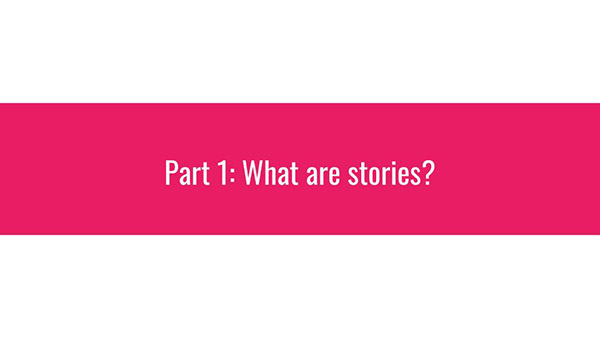
I’m assuming in a room full of writers the concept of stories and storytelling is far from new. So let’s collectively take a whack at this question.
What are stories? Anyone?
***take audience answers***
Other definitions are…
A fictional account of imaginary people.
A recounting of events.
A rumor, report, or a lie.
Something with a beginning, a middle, and an end.
I don’t know about you, but when I want to apply storytelling to my work as a content creator and publisher these definitions aren’t very helpful.
I have found, that to get to a truly useful definition of stories, we have to ask a different question.
Why Do Stories Exist?
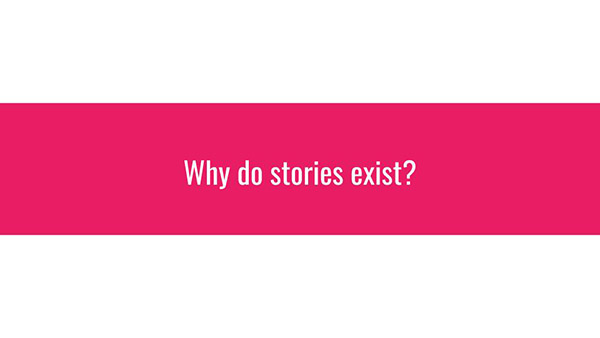
Why do stories exist in the first place? What is their function? What purpose do they serve from, say, an evolutionary perspective?
Have you ever thought about that?
These are really interesting questions that get right down to the core of what it means to be a human being and how we experience our existence.
(I bet someone in here is thinking to themselves right now, “I did not sign up for this deep of a talk today.”)
I promise you, if you stay with me on this I will give you something useful by the end.
Now again, seeing as this is a room full of writers who have likely had liberal arts educations, I’m sure many of you know that loads of brilliant people have dedicated their careers in whole or in part to pinning down an answer to these questions.

There’s Carl Jung’s work on symbols, archetypes, and the collective unconscious.
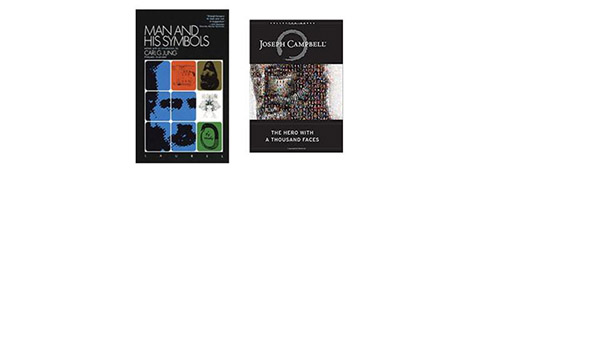
Joseph Campbell’s Hero’s Journey.
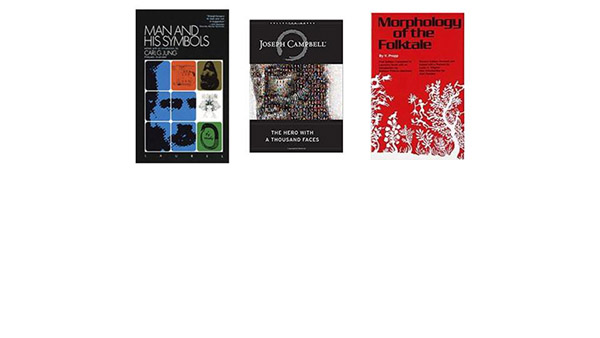
V. Propp’s Morphology of the Folktale.
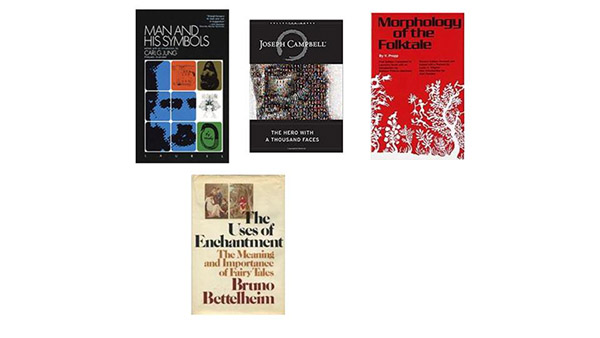
Bruno Bettelheim’s The Uses of Enchantment.
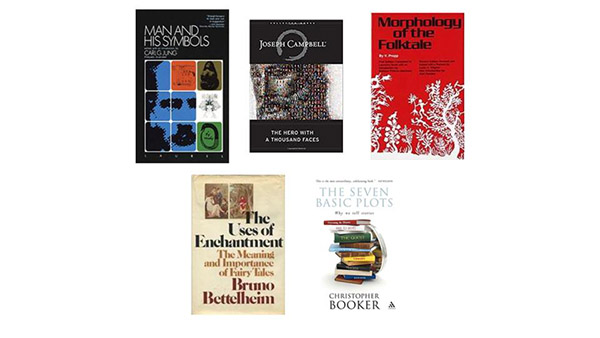
Christopher Booker’s Seven Basic Plots.
And countless others, old and new.
What’s interesting is that when you spend a decent amount of time studying these peoples’ work, you begin to see stories differently…
Story Structure

You begin to see stories as essential to the way human beings think. The way we order our thoughts. And the way we filter our experiences to make sense of the world.
You begin to see the underlying structure and elements of stories–the things they nearly all have in common, regardless of how unique they seem on the surface.
You can even start to see how those elements work together to accomplish the specific goals of the storyteller. And once you understand that, you can begin to play with those elements yourself. Pulling them apart and putting them back together again until you’ve told a story that’s yours and says what you want it to say.
Now, it should be noted: many of those writers and thinkers I just cited believed that they had cracked the code when it came to stories. That their theory on narrative structure and archetypes was and is the universal one. And a lot of people in my position would naturally want to agree. It would sure make my presentation more authoritative. But it’s just not true.
I’m a far cry from a world class academic (or an academic at all) but even I have found deficiencies in every universal theory on narrative structure and archetypes I’ve come across. But that doesn’t mean the ideas aren’t worth familiarizing yourself with. It just means that psychology and literary analysis are not hard science. You can’t be too literal with their application. But by using these ideas as guideposts in your storytelling process you can gain a mastery over the craft that, I believe, is hard to get without it.
Ok, end of disclaimer.
Let’s proceed.
Since it’s really hard to discuss such an abstract topic without some visual aids, we’ll be using a diagram.
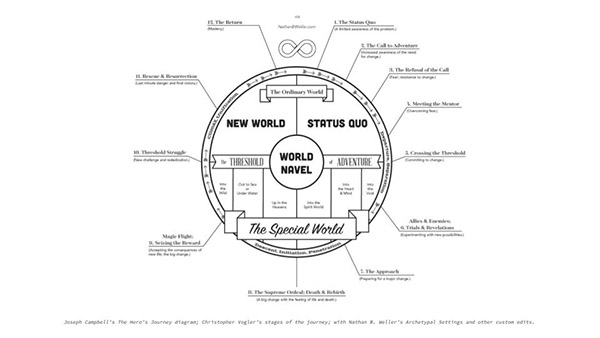
This particular diagram is one I created by combining ideas from just about all of the sources I listed on my previous slides (and a few I didn’t). Not to mention I’ve added some ideas that help me personally but weren’t something I picked up from anyone else.
Don’t worry, I’m not going to go through this diagram point by point.
(Trust me, we do not have time for that.)
However, I can give a high-level overview that will (hopefully) help you to think about stories a little bit differently too and give us a common “story vocabulary” to work with for the second part of the presentation. Once we complete the overview we will be able to circle back to our initial question of what stories are and then conclude with tips on how to use them as publishers.
To begin, let’s get rid of the visual noise and talk about just the major elements of this diagram…

First, I want you to imagine this dot is a story. We’re viewing it from a distance. If we zoom in, we can begin to make out its individual components.
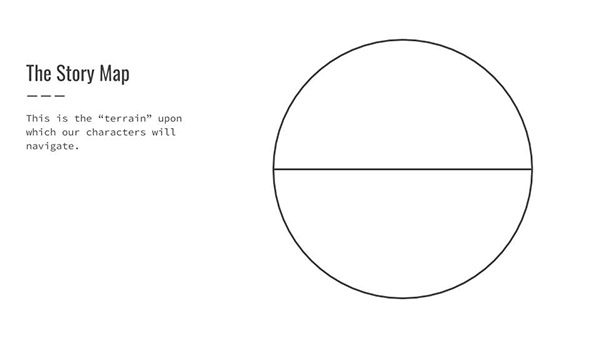
This is our story map. The “terrain” if you will, upon which our characters will navigate. Up close we can see there are two halves, a top and a bottom.
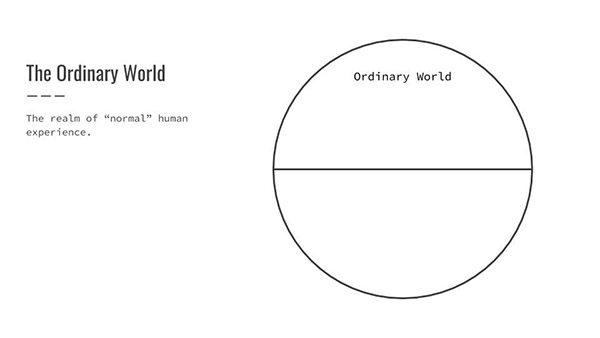
The top half is called The Ordinary World. This is the realm of “normal” human experience for our story’s protagonist or hero. This is not a “universal normal” just normal for them.
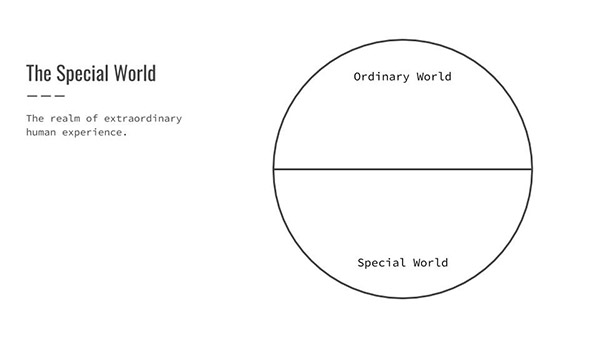
The bottom half is called The Special World. This is a realm outside of the hero’s ordinary experience. Outside their “comfort zone” you might say. The function of the special world is to transform the characters as they pass through it.
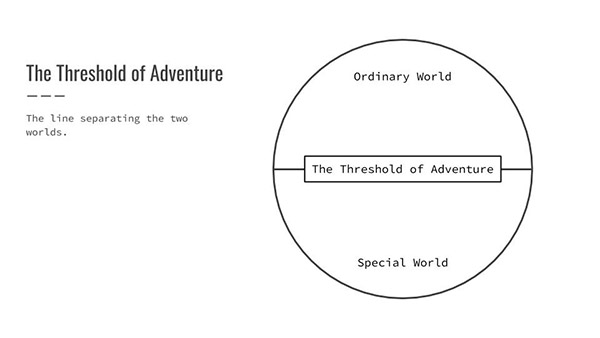
The line that separates these two worlds is called The Threshold of Adventure. Think back to The Matrix. It’s the Red Pill or the Blue Pill. Once you make your choice, there is no going back.
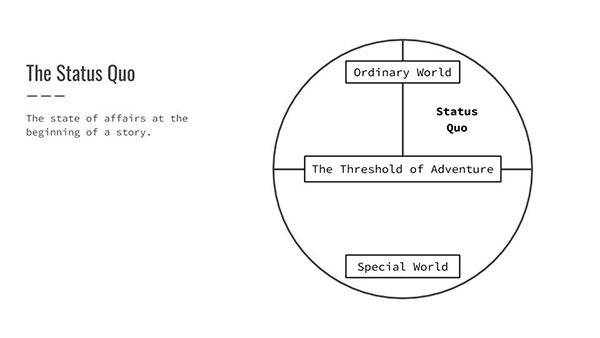
Every story begins with a Status Quo. A normal state of affairs that defines the Ordinary World. This can be good or it can be bad. It could be a peaceful village, like The Shire, in the Lord of the Rings. Or it could be a city like Gotham in the DC Comics Universe, crumbling from the inside with crime and corruption.
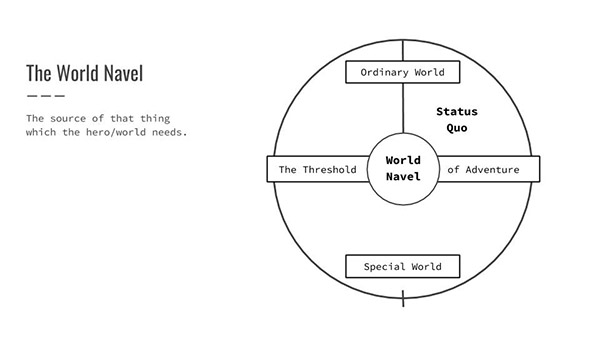
At the center of everything lies The World Navel. This is a symbol representing that thing which the hero and/or the world needs. If you’re telling a redemption story it could be the source of Forgiveness. If you’re telling a monster slaying story, it could be the source of magic or technology needed to defeat it.
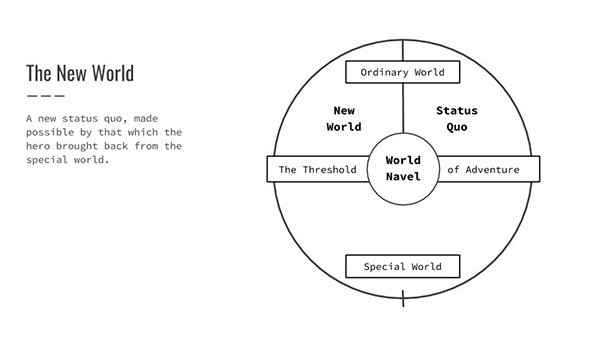
And finally, when we cross back over The Threshold of Adventure on the other side of our Story Map, we’re in a new (ordinary) world. One that has been made possible by the power brought back from the Special World by a transformed hero.
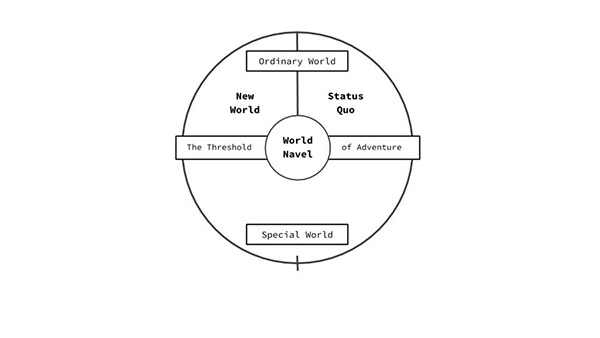
These are the regions of our story map. As characters progress around the map, from Status Quo, across the Threshold of Adventure, into the Special World, and back out the other side, we can identify these movements and group them into stages.
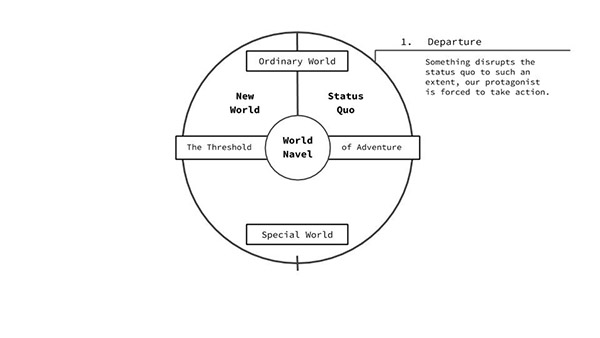
In this first stage, called Departure, something disrupts the status quo to such an extent that our protagonist is forced to take action. This could be evil black riders coming from Mordor, forcing Frodo to flee the Shire. Or it could be Bruce Wayne’s parents, dying tragically as a result of Gotham’s rampant crime. Sending Bruce on a journey that would turn him into Batman.
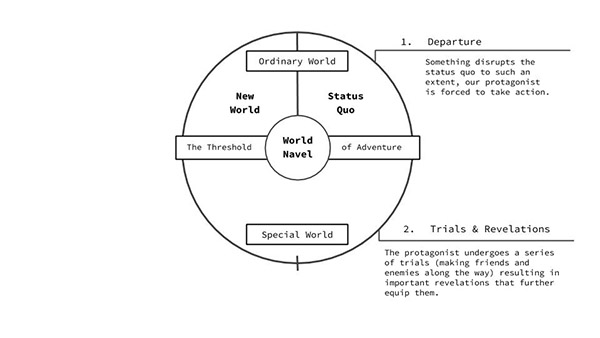
In the second stage, called Trials & Revelations, the protagonist undergoes a series of tests (making friends and enemies along the way) resulting in important revelations (or lessons) that further equip them to achieve their ultimate goal.
Think, Harry Potter.
A young boy leaves the ordinary world to enter into a magical world. He’s destined to defeat the evil wizard who killed his parents, but before that he undergoes a series of trials each year at school. As he overcomes these trials he is strengthened by the lessons he’s learned and the friends he’s gained. And he begins to understand the nature of his enemies as well. Both the small ones like Malfoy at school and the big ones like Death Eaters and Voldemort.
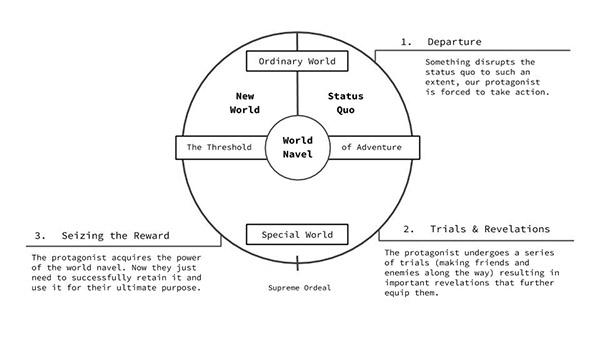
The third stage is called Seizing the Reward. And before we talk about it, we have to address the implied question: a reward for what?
And the answer is: passing through something known as the Supreme Ordeal.
You may have noticed that for a while now my diagram has had a little dash at the bottom center. This is to indicate the crucial event in which the hero of the story must confront death either literally or figuratively.
It is this act that earns a reward. And it’s in the third stage, Seizing the Reward, when the protagonist acquires the power of the World Navel. Usually saving them in the moment, but not completely. There is almost always another climactic confrontation still to happen.
This can be hard to understand without some good examples.
First, let’s start with a figurative example…
Figurative Example – The Devil Wears Prada
The hero of the story, Andrea, confronts the possibility that she’s killing her career by finally standing up for what she believes in and quitting her job as the personal assistant to the most influential person in Fashion.
Her reward?
Her dignity, autonomy, and personal sense of right and wrong are restored.
She still has to figure out her work situation and patch up the broken relationships in her life, but she’s faced the thing that she needed to face in order to lead a life that’s about more than ruthlessly climbing a career ladder or putting money in her bank account.
Literal Example – Harry Potter
In the Battle for Hogwarts the forces of Voldemort are winning. Harry is given the choice. Force everyone to fight to the death or to surrender himself–saving everyone else. Harry turns himself over to be killed by Voldemort. When the crucial blow is struck however, Harry is not instantly killed. Instead he is taken to a sort of in-between place where he has a profound realization. He had come to believe that he was powerful, talented, and “chosen” because of character flaws he shared with the evil Voldemort. His identity was all mixed up because of a spell that was cast on him as a baby–bonding him and Voldemort together. It wasn’t until that moment that he realized his strength and capacity was his own–rooted in his values, his friends, and his family. He could choose to live and let the evil part die. Which he does.
His reward?
He lives! He still has to win the battle, of course. But now he knows where his strength really lies. And together with his friends, his family, his community–they can stand up for the values that make the Wizarding world worth living in.
—
Literal Example 2 – Indiana Jones and the Last Crusade
Indiana Jones, faced with the imminent death of his father and the very real threat of Nazis seizing control of the Holy Grail (which they plan to use as a means of achieving immortality for themselves) must make a choice. An ancient knight who has been guarding the Cup of Christ for over a thousand years tells him that he can have the Grail if only he can successfully pick it out among a room full of other cups. He must choose one, drink from it, and if he survives he will have chosen wisely. The Holy Grail will be his. If he does not choose wisely, he will die instantly.
His reward?
Well, first of all, he doesn’t die. But more importantly, in choosing the correct cup (which he was only able to do because of everything he learned during his trials and revelations) he is able to use the Grail to heal his father.
He still has to figure out a way to keep the Holy Grail from the Nazis, but by passing through his Supreme Ordeal he is able to literally heal his father in the moment while also opening up the possibility for a deeper healing of their relationship in the future.
Literal Example 3 – The Matrix
Neo, believing himself not to be “the one”, he chooses to sacrifice himself to save his mentor. This act–comprised of escalating fights with more and more powerful foes–has a transformative effect on him. He realizes, bit by bit, as he does what should be impossible, that he is “the one”. And once he comes to that understanding, not even getting shot repeatedly at point blank range can kill him inside the Matrix.
His reward?
Again. Not dying. But also, he now has the power to manipulate the simulation known as the Matrix even better than its creators. He now has the power to fight for a new world.
—
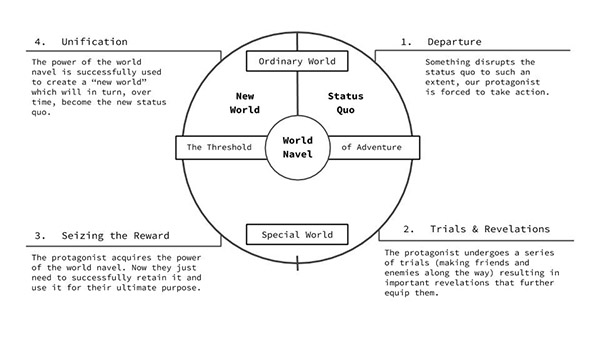
Which brings us, finally, to stage four: Unification.
In this stage the final confrontation happens. The war is won. All of the loose ends are tied up. The power of the world navel is successfully used to create a “new world” which will in turn, over time, become the new status quo.
—
Pretty simple right? But wait, there’s more!
The Seven Basic Plots
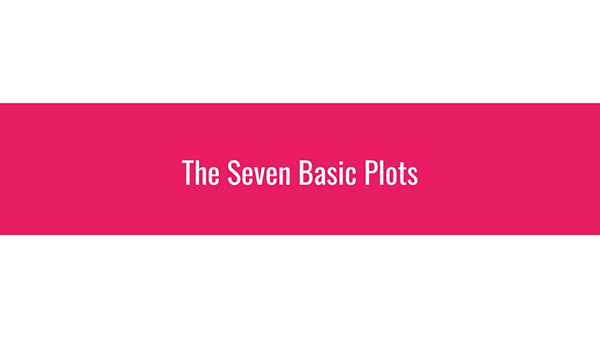
It turns out there are some extremely tried and true paths through the story map. These are known as archetypal or basic plots.
These are all pulled from the book I mentioned earlier by Christopher Booker–The Seven Basic Plots.
First up…
Overcoming the Monster
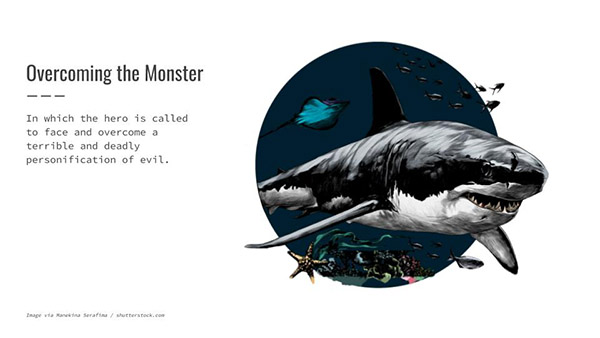
In which the hero is called to face and overcome a terrible and deadly personification of evil.
This personification could be a great white shark, as in Jaws. Or it could be a sociopathic bureaucrat, such as Hans Landa in Inglourious Basterds.
Rags to Riches
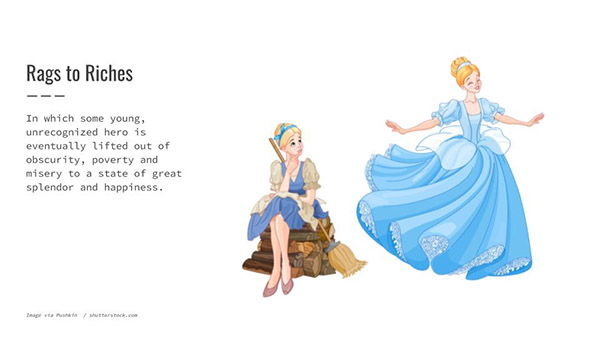
In which some young, unrecognized hero is eventually lifted out of obscurity, poverty and misery to a state of great splendor and happiness.
Think Cinderella, which is probably the most popular example of this plot. And of course, The American Dream; every story of someone starting from the bottom and making it to the top.
The Quest
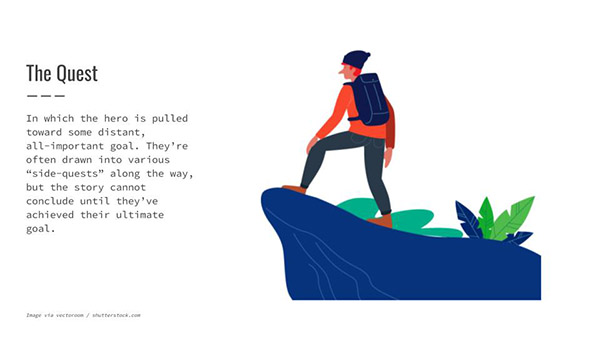
In which the hero is pulled toward some distant, all-important goal. They’re often drawn into various “side-quests” along the way, but the story cannot conclude until they’ve achieved their ultimate goal.
This plot is extremely popular. The best (popular) example in recent history both in literature and cinema is probably The Lord of the Rings.
Voyage and Return
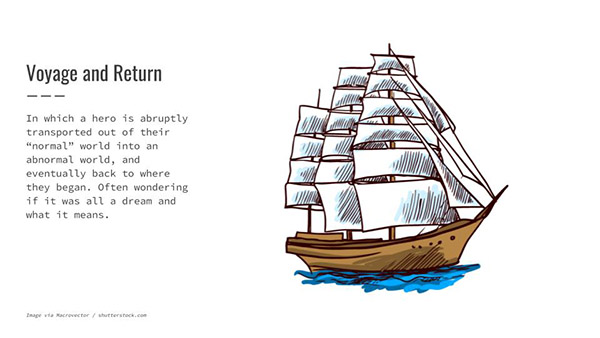
In which a hero is abruptly transported out of their “normal” world into an abnormal world, and eventually back to where they began. Often wondering if it was all a dream and what it means.
Think, Alice in Wonderland and The Wizard of Oz.
This is a really useful plot for connecting with people in their mid to late twenties. They’ve left home, passed through the special world of college, acquired tons of interesting experiences and debt, and now they’re back in the normal world working whatever low paying job they can get–wondering what it all means.
Comedy
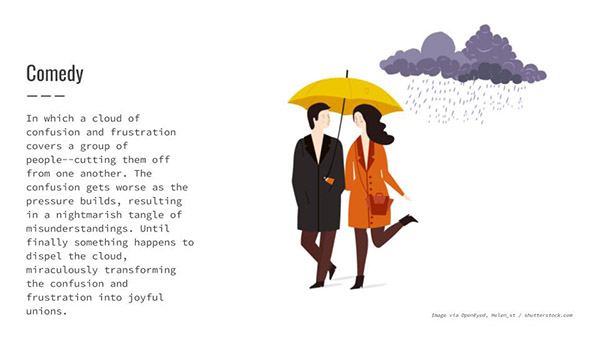
In which a cloud of confusion and frustration covers a group of people–cutting them off from one another. The confusion gets worse as the pressure builds, resulting in a nightmarish tangle of misunderstandings. Until finally something happens to dispel the cloud, miraculously transforming the confusion and frustration into joyful unions.
This is just about every romantic comedy you’ve ever seen. I think the movie Hitch is a great example. Things are going well, misunderstandings happen that push the potential lovers apart, when suddenly all is cleared up and there are weddings and dancing during the end credits.
Tragedy
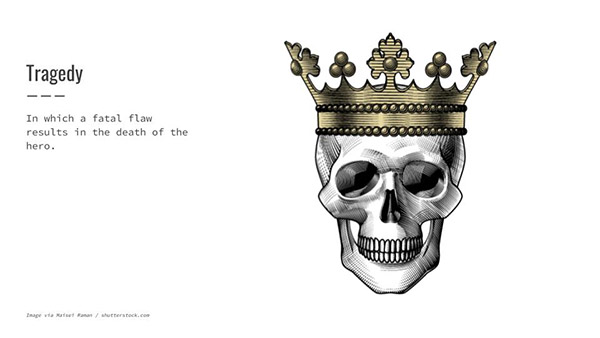
In which a fatal flaw results in the death of the hero.
What better examples than Hamlet or Romeo and Juliet? Romeo and Juliet being a story that could easily have been a comedy, but it takes a tragic turn, and instead of a wedding we have a funeral.
Rebirth
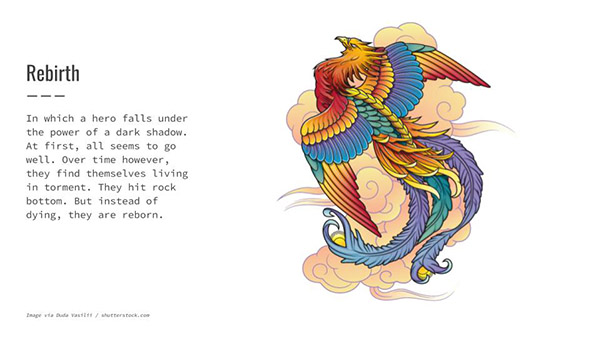
In which a hero falls under the power of a dark shadow. At first, all seems to go well. Over time however, they find themselves living in torment. They hit rock bottom. But instead of dying, they are reborn.
This is every musical bio-pic you’ve ever seen. Rock star rises to fame while indulging in sex and drugs. Eventually, their life falls apart. They hit rock bottom. But instead of persisting in their bad behavior, they take advantage of a second chance and find redemption. Resulting in a new lease on life.
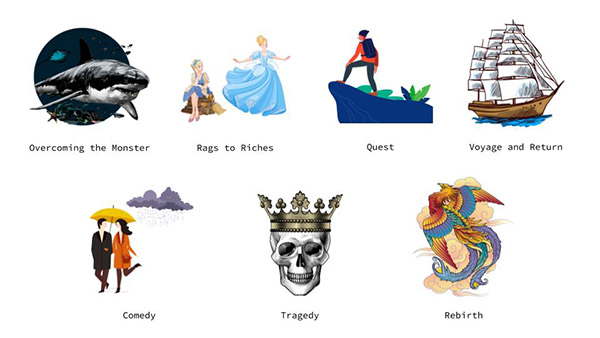
In any story you tell or experience you will likely find one or more of these plots. Which is why they are archetypes. The most common of common plots, so ubiquitous as to be universal. And in doing so, saying quite a lot about what it means to be a human being.
Speaking of which, we haven’t talked about characters yet.
Archetypal Characters
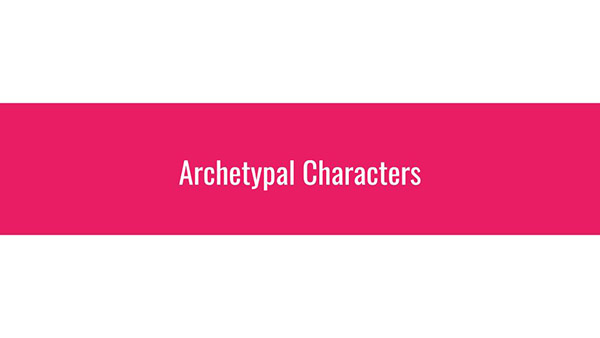
Every story has a cast of characters. And they all spring from variations of basic archetypes. Depending on who you’re talking to, there are potentially dozens of essential archetypal characters. But for our purposes today, I’d like to highlight just four.
The Hero
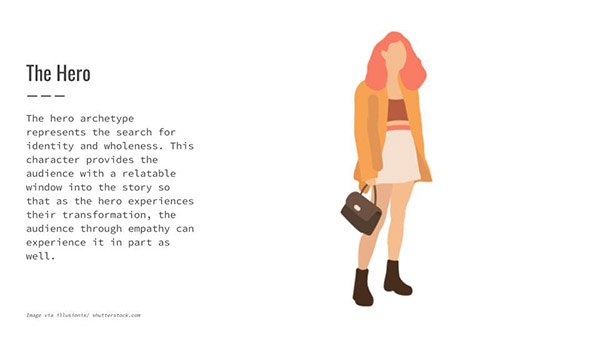
The hero archetype represents the search for identity and wholeness. This character provides the audience with a relatable window into the story so that as the hero experiences their transformation, the audience through empathy can experience it in part as well.
The Mentor
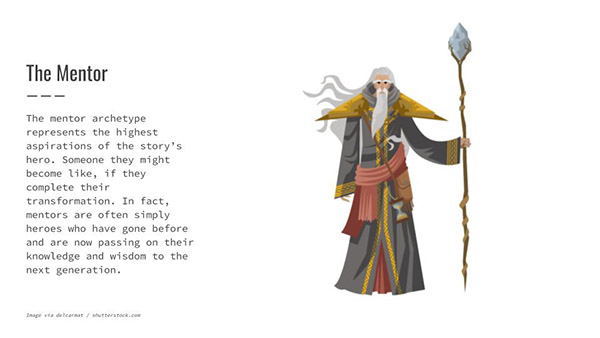
The mentor archetype represents the highest aspirations of the story’s hero. Someone they might become like, if they complete their transformation. In fact, mentors are often simply heroes who have gone before and are now passing on their knowledge and wisdom to the next generation.
They are also notable gift givers. They almost always have some object of power or particular usefulness they bestow upon the hero. This item is usually key in helping the hero unlock whatever it is they need to unlock in order to access the power of the World Navel. It could be a key, information, computer code, or my personal favorite—a magic sword.
The Ally
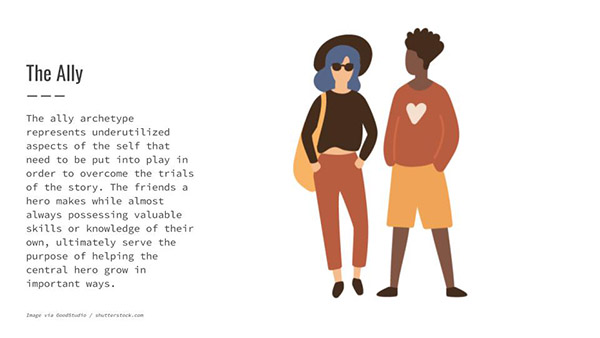
The ally archetype represents underutilized aspects of the self that need to be put into play in order to overcome the trials of the story. The friends a hero makes while almost always possessing valuable skills or knowledge of their own, ultimately serve the purpose of helping the central hero grow in important ways.
The Shadow
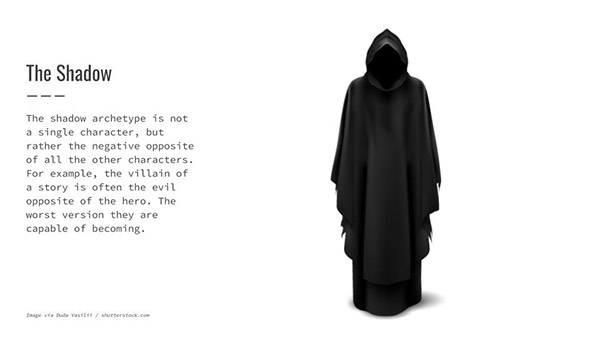
The shadow archetype is not a single character, but rather the negative opposite of all the other characters. For example, the villain of a story is often the evil opposite of the hero. The worst version they are capable of becoming.
What Are Stories? (Revisited)
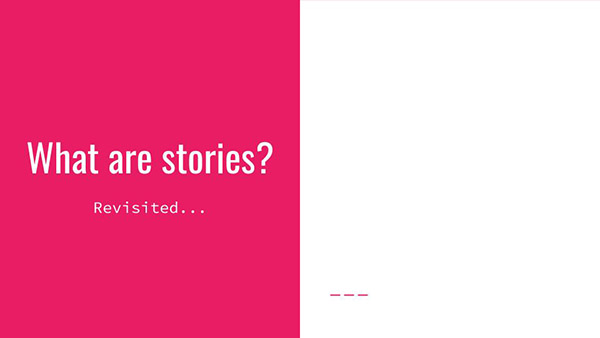
Whew! We made it. We now have a shared vocabulary about stories and some valuable touch points we can refer back to for the rest of the talk.
We understand that stories can be mapped. That there are significant regions to the map. That there are seven primary paths through that map. And that archetypal characters represent important states of being both in the story itself and in the audience.
So, let’s revisit our initial question and answer it in three ways that will help us as content creators, publishers, and designers/developers.
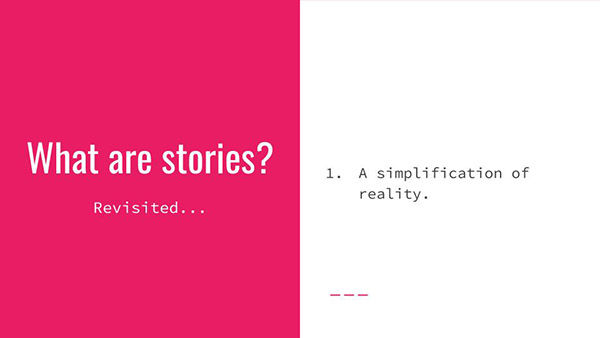
A story is the simplification of reality, usually with the aim of highlighting just the details that convey the storyteller’s intended message.
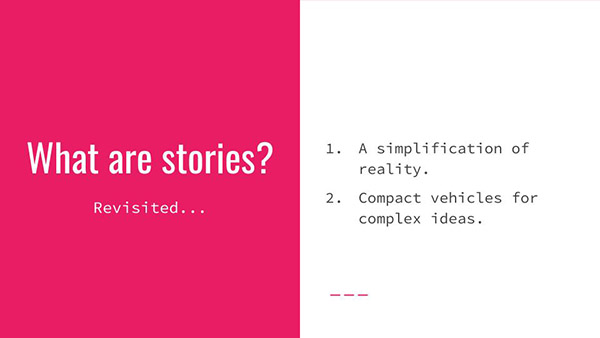
A story is an incredibly effective vehicle for ideas and information. Even when simple in nature, they can communicate complex ideas on a multitude of levels.
Ideas about the self.
Ideas about one’s relationship with others.
Ideas about one’s relationship with their culture.
Ideas about one’s place in the world.
Which brings us to the final definition of a story I want to cover…
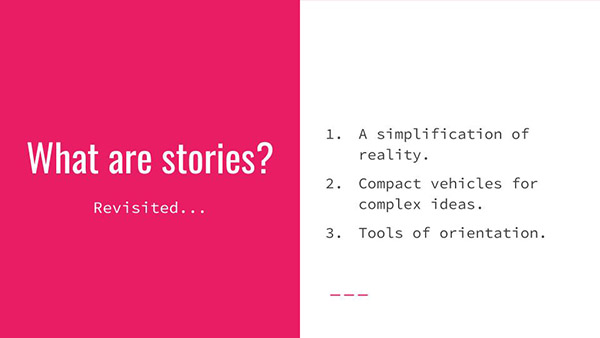
Stories are tools we use to orient ourselves.
Once we have a sense of ourselves, how we fit into our family unit, our tribe, culture, and world–then we can live our lives without having to constantly navigate difficult existential questions all of the time. We simply plot our new experiences into the stories we tell ourselves about ourselves and the world we live in.
These stories, collectively, form the running narrative of our lives and perception of reality.
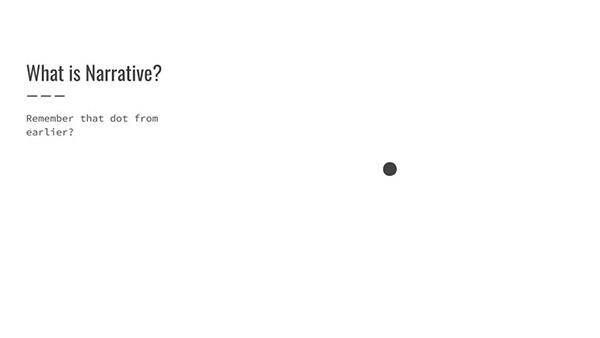
Remember that dot from earlier? The one that, if we zoom in on it, we see the story map? Well now we’re zoomed out again. And instead of focusing on one story…

…we can see that there are lots of stories…
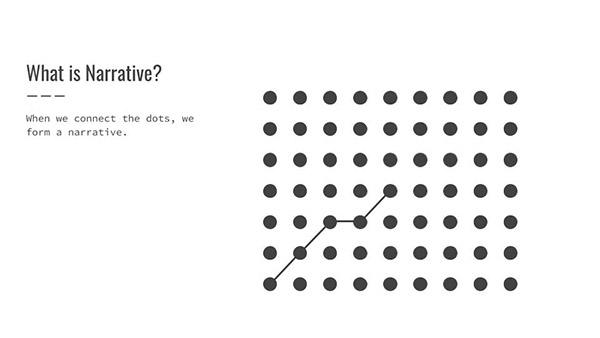
…and if we begin to connect one dot to another, we get an ongoing narrative. This concept of narrative is going to be really important here in part 2.
Part 2: Storytelling in Online Publishing
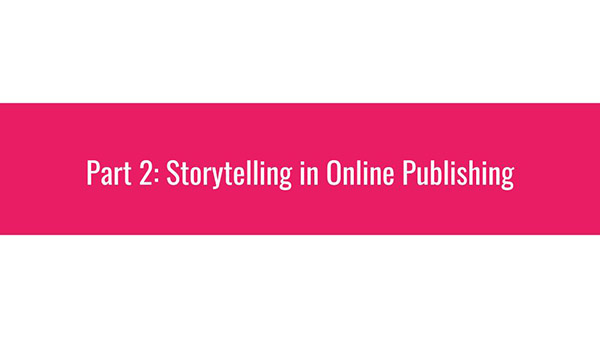
I’d like to begin by pointing out a few key takeaways that I believe everyone here can benefit from. Then we’ll get more specific.
3 Key Takeaways
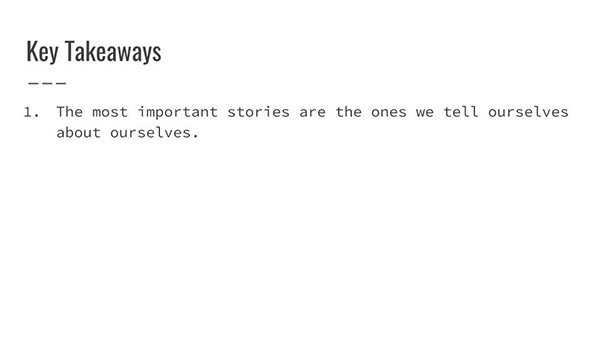
1.The most important stories are the ones we tell ourselves about ourselves. These stories determine our identity and what we believe in on the deepest levels.

2.By extension, the most important story you can tell to others is one that puts them in the lead role. Either directly or through a proxy.
If you want an idea of how powerful this practice can be, just pay close attention to the messaging coming out of the various political camps during this election (or any past election for that matter). There are some potent narratives out there.
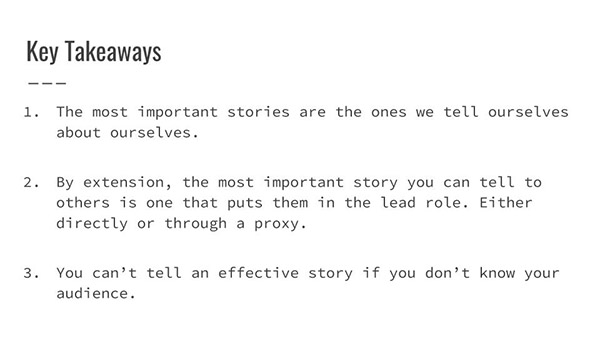
3.You can’t tell an effective story if you don’t know your audience.
I don’t just mean the group of people you’re trying to communicate with. I mean understanding that group on a values and identity level.
Which is a great segway into clearing up some common misconception about storytelling in online publishing…
Common Misconceptions
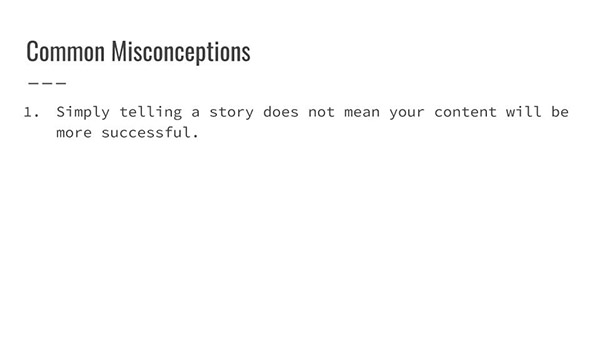
1.Simply telling a story does not mean your content will be more successful. It has to be the right story.
Does it place your audience in the lead role, either directly or through a proxy?
Does it speak to something they value? Something they need or believe others need to make the world a better place?
Does it fit into their larger personal narrative? Or does it conflict with it?
Or are you just whiffing entirely and telling a story they don’t care about?
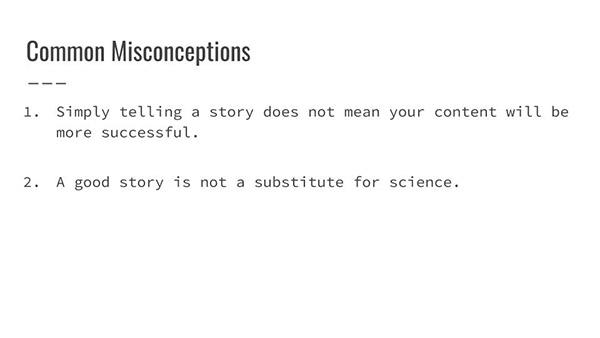
2.You may have heard the saying, “don’t let a fact get in the way of a good story.” That’s because it happens all the time.
Let’s recall our first definition of a story. A story is a simplification of reality for the purpose of highlighting just the details the storyteller needs in order to convey their message.
It’s important to remember that the very act of simplification that makes storytelling effective also makes it dangerous. By simplifying reality, reality is distorted. And when reality is distorted truth does not always come out the other side.
Stories can be used effectively to tell both truth and lies which resonate deeply with their audience.
I have found that the best way to counter this is to pair your storytelling efforts with good science. If your story makes a claim, prove it with data. This will ensure that the stories you tell yourself and others don’t become delusions but stay anchored to reality.
Another important point to make in terms of story vs science. When it comes to content strategy, data should come before the story. Work with the best SEO strategy, pay attention to what your analytics are saying, and then using the craft of storytelling to move the needle in the right direction. Don’t try to do it the other way around. Otherwise you may end up with some incredibly crafted content that no one finds or engages with.
Storytelling Essentials for Publishers & Editors
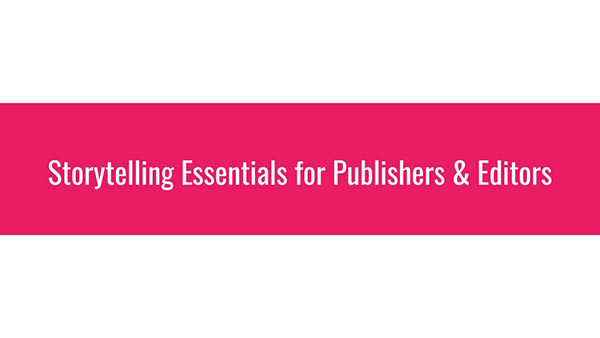
Ok, now let’s get specific to one of the groups present here today: Publishers and Editors. The people running online blogs, newspapers, and magazines. My number one recommended use of storytelling for you is Story Branding.
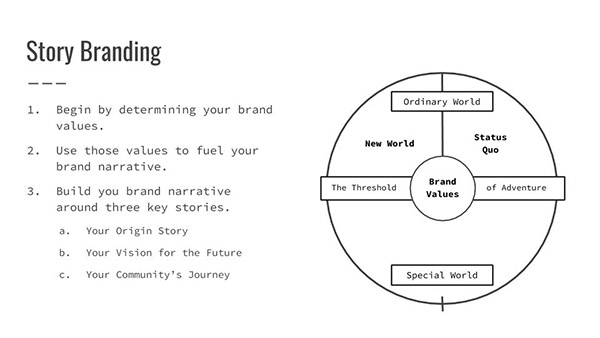
The goal of story branding is to integrate your brand with the identity of your readers.
You can begin by determining your brand values. These should be values shared by both you and your audience.
Journalistic values, for example, might include: truth, objectivity, accountability, and transparency.
You’ll want to use those values to fuel your brand narrative. You can see on my altered diagram, brand values live in the very center. They are the thing your audience and the world need.
And finally, build your brand narrative around three key stories.
Your Origin Story – this is the story of why your brand exists. It should be rooted in a desire to honor your brand values.
Your Vision for the Future – this is your idea of a new world. A world that has experienced your brand values and been re-made by them.
Your Community’s Journey – this is the day to day story, starring your audience, in which they are aided in their quest to make a new world based on your shared brand values through the use of your gift to them. Your content.
To do this successfully, it’s crucial that you get the casting right.
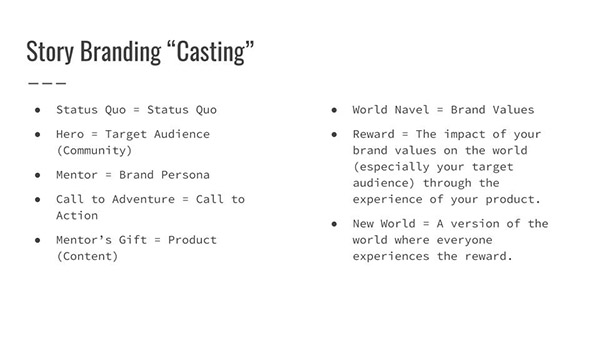
Status Quo = the world as it seems to your target audience.
Hero = your target audience. Your community.
Mentor = your brand persona. The embodiment of your brand values.
Call to Adventure (that thing that eventually gets the hero to engage) = that’s your call to action. Subscribe! Become a member! Join the community.
Mentor’s Gift = that’s your product! Your content. The thing that allows your audience to channel the values you share. By consuming your content and by sharing it with others.
World Navel = your brand values.
Reward = the impact of your brand values on the world (especially your target audience) through the experience of your product.
New World = a version of the world where everyone experiences the reward.
Storytelling Essentials for Content Creators
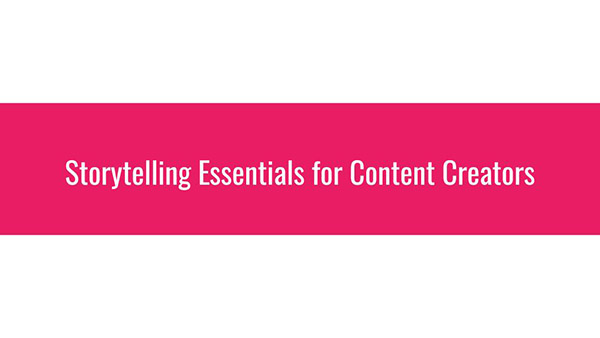
I have three storytelling tips for content creators.
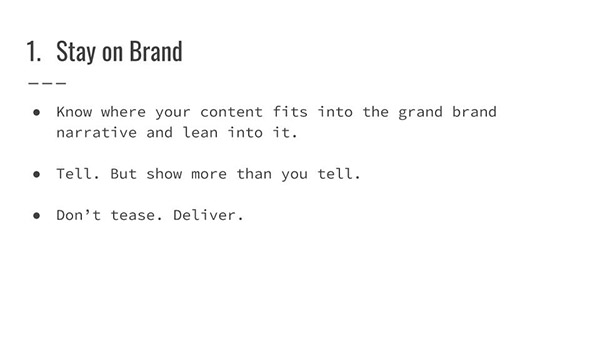
Stay on brand by always knowing where your current work fits into the grand brand narrative and lean into it.
Tell. But show more than you tell. This is something every writing or acting instructor harps on. You can and should shout your brand values from the rooftops, but demonstrating them in the way you create your content will always say more.
A continuation of that point is, don’t tease. Deliver. Don’t simply promise truth, objectivity, accountability, and transparency. Deliver it.
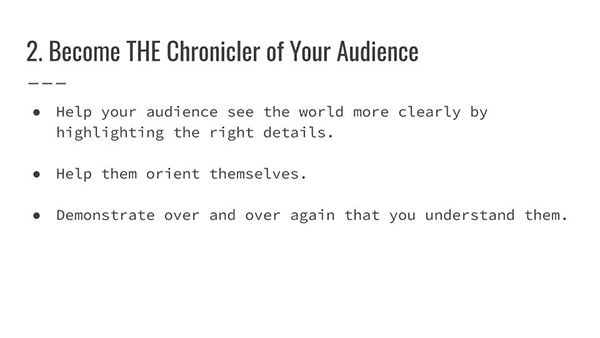
Become THE chronicler of your community’s adventures.
Help them see the world more clearly by highlighting the right details.
Use story structure, archetypes, and all of the principles and elements of storytelling to help your readers orient themselves.
To do any of this, you must know your audience as deeply as possible. And you’ll want to demonstrate that as often as you can to gain their loyalty.
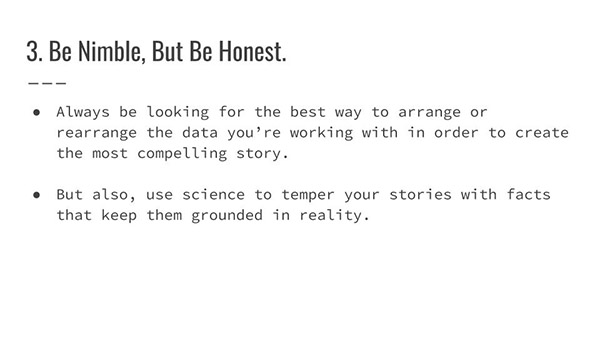
Always be looking for the best way to arrange or rearrange the data you’re working with in order to create the most compelling story.
But also, use science to temper your stories with facts that keep them grounded in reality. It’s easy to use your storytelling powers to become a spin doctor, but manifesting delusions for clicks or profit does not do the world any good.
Storytelling Essentials for Designers & Developers
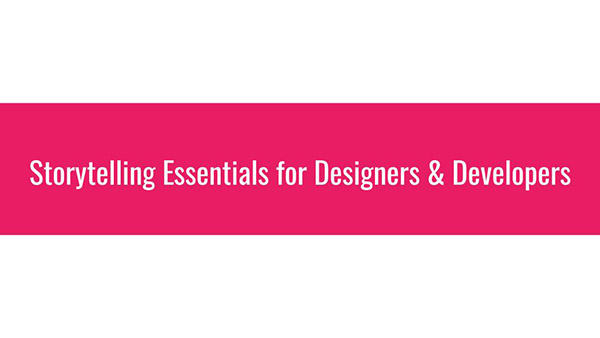
You’re like the set designers, costume designers, and prop creators in a movie production. The big wigs are setting up the big picture. The writers write the stories. And you bring it all to life. Notably, in two ways: user experience and user journey.
Let’s talk user experience first.
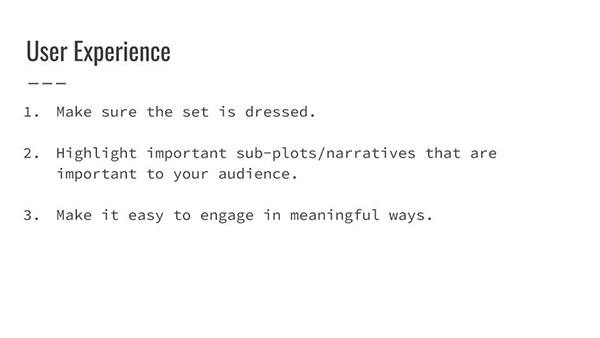
Make sure the set is dressed. When someone lands on your website, does it look and feel like the kind of publication that stands for the values your brand stands for? Does it instantly connect with where your target audience is and make them feel empowered to use this gift in their life? Would they want to share it with others that are like minded?
Highlight important sub-plots/narratives that are important to your audience. This is one I see extremists do well. Sadly. If you go to extreme right wing or left wing political websites, their categories often don’t even look like categories. They’ll say things like “The War on Christmas” and function as a collection of stories (or narrative) that uses reporting on specific events to tell a story of persecution.
Make it easy to engage in meaningful ways. To me this goes beyond the ability to leave comments or share on social media. I think this should first and foremost include readability. Making sure the design of the site gets out of the way so that the thing everyone is collectively striving to bring to the audience is actually readable or viewable.
Another idea might be innovating in ways that allow your audience to engage in novel ways that they find meaningful. I think a great example of this is WikiTribune. They’re open sourcing journalism by allowing their readers to contribute through fact checking and all kinds of neat things.
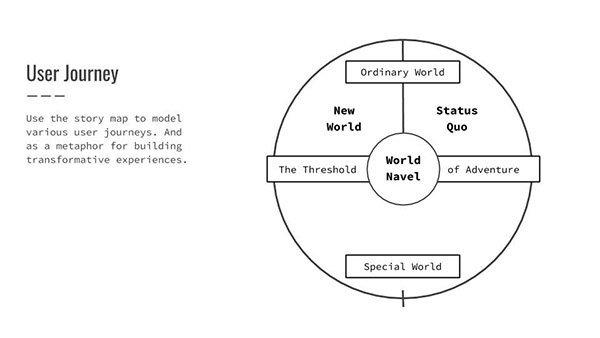
Use the story map to model various user journeys. And as a metaphor for building transformative experiences.
When someone logs into your website, which might be seen as crossing a threshold of adventure, what kinds of transformative experiences are you providing?
Any Questions?

I didn’t get to answer questions at the end of my presentation due to time restrictions, but in the comments below I would be happy to field any questions you have.
If you need story consulting, I can likely help you with that too. Because I have a full-time job with Elegant Themes I can’t do long-term implementation of these ideas for clients. However, I can do scheduled virtual sessions to help teams and individuals use these storytelling principles within their specific business. To schedule one of these sessions you can reach out to me here.
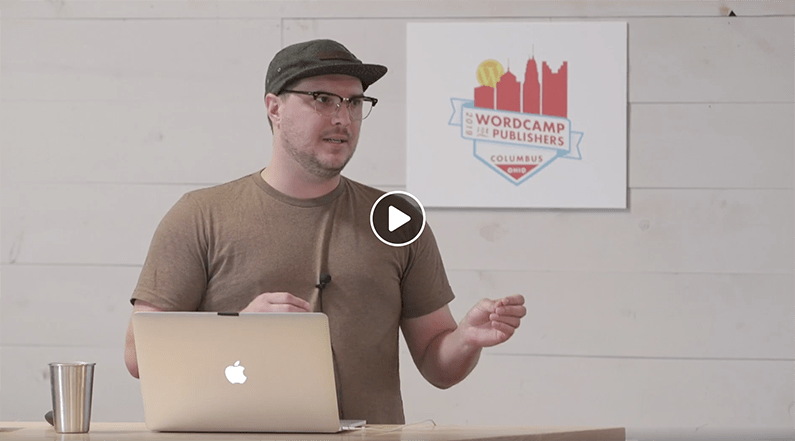
Great talk, Nathan! I deal with storytelling through content marketing all the time but never spent time researching the topic or analyzing the structure of stories. Thanks for sharing your knowledge (and stay safe buddy).
Thanks Vova! Hope you and yours are well.